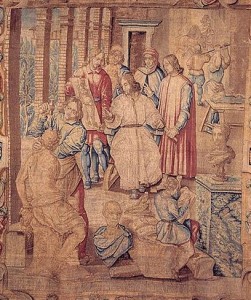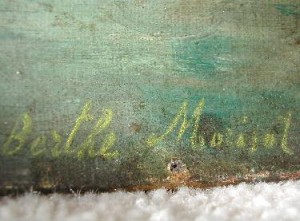
Designed by Johannes Stradanus
“Lorenzo de’ Medici in the Sculpture Garden,” 1571 [detail]
Tapestry, 167 5/16 x 179 1/8 in.
Museo Nazionnale di San Marco, Pisa
When he was only fifteen, Michelangelo was invited by the ruler of Florence, Lorenzo de’Medici, il Magnifico himself, to live in his palace and be trained in a school that he had established to foster the next generation of Florentine master sculptors. The sculptors were taught by an old man, Bertoldi di Giovanni, the last living student of the great Renaissance sculptor, Donatello. When Michelangelo arrived, the school’s star pupil was Pietro Torrigiani, a talented artist three years older than he was.
According to the Renaissance biographer Vasari, the day Michelangelo first visited Lorenzo de’Medici’s garden he noticed Torrigiani making small clay figures. Michelangelo thought he could do better, found some clay, and preceded to do just that. Torrigiani learned quickly that he was now facing a formidable rival. Soon his fellow students were studying the new arrival’s drawings, not his. At the dinners in the Medici Palace, he couldn’t help noticing that Michelangelo was often found sitting next to Lorenzo de’Medici himself — closer than il Magnifico’s own children.
Continue reading →
 Andrew M. Goldstein of Artspace.com has put together a useful collection of modern and contemporary artist names for anyone who has wondered if they were wrong. Boy, I could have used this when I first started teaching. Not that I still don’t need this. I’ll be sneaking a peak at this list for years to come. Don’t forget the link at the bottom with page two and more help.
Andrew M. Goldstein of Artspace.com has put together a useful collection of modern and contemporary artist names for anyone who has wondered if they were wrong. Boy, I could have used this when I first started teaching. Not that I still don’t need this. I’ll be sneaking a peak at this list for years to come. Don’t forget the link at the bottom with page two and more help.



